Feb 16, 2022
Kosaka, Akita: Where mining heritage meets magnificent nature
Gallery - Kosaka Town and Lake Towada, Akita Prefecture
In the town of Kosaka in northeastern Akita Prefecture, industrial heritage and eco-conscious industry rub shoulders with some jaw-dropping nature to make for an experience of northern Japan that is as impressive as it is surprising.
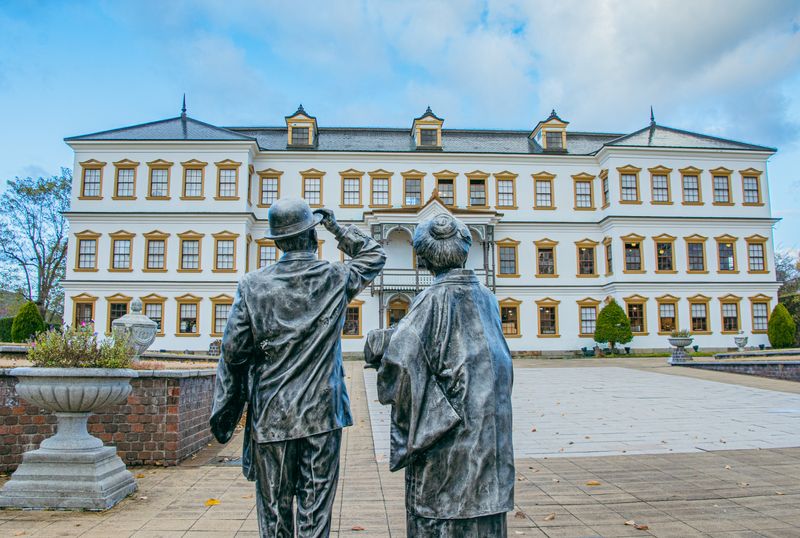
(The Kosaka Mining Office, Meiji Hyakunen-dori, Kosaka)
Maybe the idea of visiting a former mining town in a far corner of the deepest regions of northern Japan doesn’t hold much appeal for you. You might be wrong. We were.
The town of Kosaka (population under 5,000), like many former mining communities across the world wears its mining heritage like a badge of honor. The mines here may have closed, and a source of economy since established above ground, but you get the impression that Kosaka is and always will be a mining town.
Much of Kosaka’s mining and industrial heritage is celebrated with no shortage of pomp and splendor along Meiji Hyakunen-dori. The broad avenue in the center of town is home to a number of buildings and facilities which were established to support the local mining industry and its workers during the Meiji era after which the avenue is named.
For many visitors, the crowning glory of Meiji Hyakunen-dori will likely be the Kosaka Mine Office, a 2001 reconstruction of which sits plump and proud at the avenue’s northern end. The scale and grandeur of the office give some indication as to the growth and scale of the mining that took place in Kosaka by the time construction of the original Kosaka Mine Office was completed in 1905. This was once one of the largest mining operations in Japan.
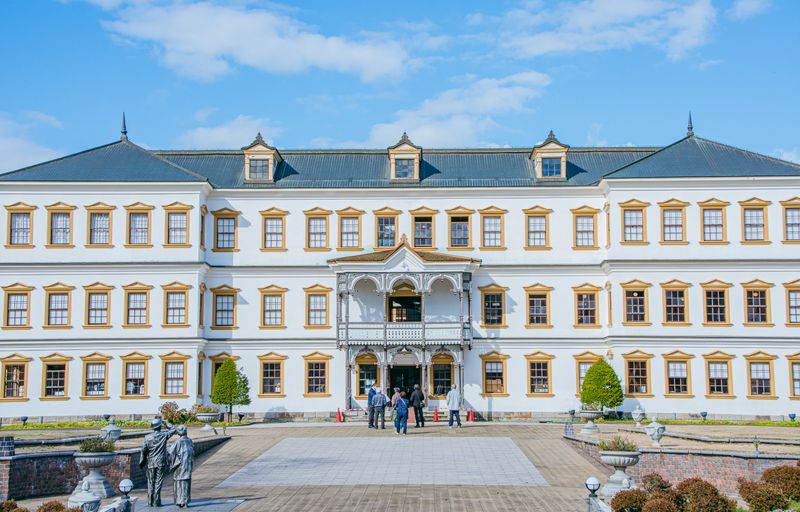
(The Kosaka Mining Office, Meiji Hyakunen-dori, Kosaka)
After the discovery of mineral deposits in Kosaka, local mining operations were established in the early 1860s to unearth gold and silver. By the early 20th century Kosaka had become something of a boom town, with its mining industry riding on the wave of modernization that came as Japan entered the Meiji era.
Under the policy, or slogan, of Fukoku-kyohei - enrich the country, strengthen the military - the Meiji government set about promoting industry across Japan, as it sought to play catch-up with the Western economies to which it had finally been exposed after centuries spent largely in isolation.
A policy of Shokusan-kogyo - promotion of industry - covered everything from the production of art to the manufacture of arms. Kosaka’s mining industry is reported to have contributed significantly to the policy, moving into the production of copper, zinc, and lead from black ore as smelting technologies improved. In the fiscal year of 1907, the production value of Kosaka’s mining was the highest in Japan, according to the Kosaka Town Development Company.
The Kosaka Mine Office was designated an Important Cultural Property of Japan in 2002. It’s a spectacularly bold structure that would make the eyes bulge even in Tokyo, let alone out here in this quiet corner of Akita.
The three story building features a white-wash, Renaissance-style exterior with signature decorative window frames and other flourishes that appear a far cry from the brutal realities of working down the mines. Front and center of the office exterior is a second-floor balcony constructed to reflect Islamic styles. Inside, a spiral staircase with a central pillar carved from a single Akita cedar, links the buildings’ three floors.
We were shown around the office by a representative of the Kosaka Town Development Company who enthusiastically pointed out the building’s European influences, including sash windows (popular in the United Kingdom) and flooring construction imported from Germany.
For lunch we dined under the high ceiling of the echoing Restaurant Akashia-tei. Today, the restaurant matches the kind of twee dining experience you can find at similar heritage properties in the West. Back in the day though, this was the room of the Fujita Club, named after the Fujita Corporation which took up the lease of the mine in Kosaka in the late 19th century. One wonders if it might have been a little more boisterous and smokey back then.
Many rooms of the Kosaka Mining Office serve as museum spaces taking visitors through the history of mining here.
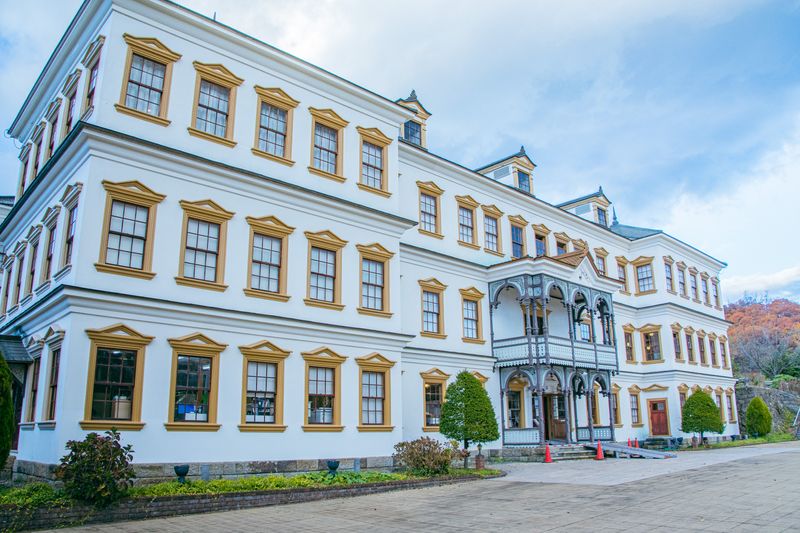
Among the exhibits and displays is information detailing the story of German engineer Curt Netto. Netto was another of Japan’s Meiji era imports from the West, invited by the Japanese government at that time to help with the modernization of the mine at Kosaka.
Netto arrived in town in December 1873, at the age of 25. He would spend four years supporting the development of the mining industry in Kosaka, as well as studying and making sketches of local life and culture, before leaving the area to become a professor at the University of Tokyo. Sketches and other works of art produced by Netto are on display in the mining office.
While the special-interest visitor may be better able to marvel at Netto’s achievements in mining, the more casual observer might be drawn to another of Netto’s legacies - the introduction of Christmas traditions to the people of Kosaka. Some sources even claim that the Christmas party Netto held with locals in the winter of 1873 is the earliest record of Christmas being celebrated in Japan. The festive season festivities continue in Kosaka to this day with Meiji Hyakunen-dori the site of an annual German-style Christmas market.
"No preservation without utilization," has been a key theme for Kosaka town planners over the last decade as they have looked toward the local industrial heritage to spearhead tourism initiatives.
Perhaps Kosaka’s Korakukan is the best example of this “preservation” and “utilization.” The marvelous Meiji-era playhouse built in 1904 to entertain mine workers and their families is still putting on shows today as the oldest existing Western-style playhouse in Japan.
We were lucky enough to be able to take in a performance at Korakukan, along with an excitable gaggle of school trippers.
We positioned ourselves in the oomuko “back seats” set on the theater’s upper tier overlooking the stage and the audience below. Oomuko seats are typically favored by the more fanatical of theater goers, from which they shout out expressions of love aimed at their favorite actors. For us though, the low-set seats presented a challenge in getting comfortable as the lights went down and the stage curtain was raised.
Although there appeared to us no audience shouts of, “They’re behind you!” the performance laid on at Korakukan reminded us of panto back home - there are no language skills required to find humor in the sight of an actor staggering around the stage playing drunk, for example. No, this is not “the theater darling.” This is foot-stomping, boldly-belching, exaggerated-swooning performance for the great unwashed. And it’s unashamedly fun.
What’s also fun at Korakukan is being able to go backstage, and under, for a closer look at the pulleys, ropes and levers that go into rotating the kaibutai performance stage and the changing of sets, among other backstage functions.
There are eight industrial heritage buildings and spots along Meiji Hyakunen-dori between the Kosaka Mine Office and the Jukai Line road that cuts east-west through town.
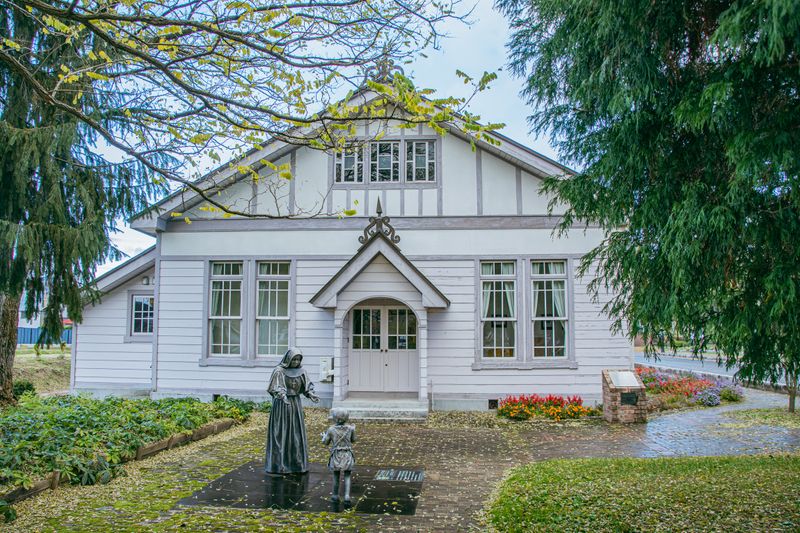
(The Tenshikan on Meiji Hyakunen-dori served as an early childhood education facility for employees of the Kosaka Mine.)
Across the road from Meiji Hyakunen-dori is the former Kosaka Station and Kosaka Tetsudo Rail Park.
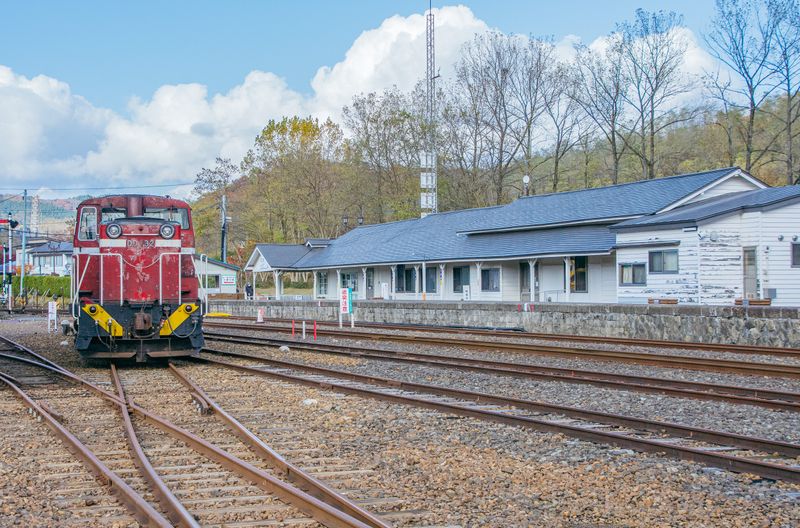
(Kosaka Station and Kosaka Tetsudo Rail Park.)
A rail company was established in Kosaka in 1909 to support the mining industry. Trains began operation the same year and would eventually start taking passengers to and from stations in neighboring Odate City.
The fate of train services operating out of Kosaka were largely, but not entirely, tied to the decline of mining here. Kosaka Railways passenger trains made their final runs in 1994, although the railway itself wouldn’t be discontinued until 2009.
Kosaka Tetsudo Rail Park showcases something of the history of the trains that arrived and departed from the Kosaka Station. Indeed, the old station building serves as the entrance to the park where visitors can get a hole punched into their park ticket in a fun, retro train-riding style.
Seemingly in-keeping with the “no preservation without utilization" theme, the rail park was offering diesel locomotive train driving experiences prior to the outbreak of the novel coronavirus. We might have been too jittery at the prospect of handling such a powerful piece of kit, but we did enjoy clambering up ladders and into stationary driver cabins under the supervision of our guide.
Especially fun was the experience of exploring the carriages of the sleeper express Akebono Series 24 train which for 44 years since 1970 used to connect Ueno Station in Tokyo to Akita and Aomori prefectures.
In more recent years the delightfully retro carriages have been operating under the guise of the Blue Train Akebono accommodation facility at the park, where guests could stay in the carriages overnight - a service that has since been suspended due to the outbreak of the novel coronavirus.
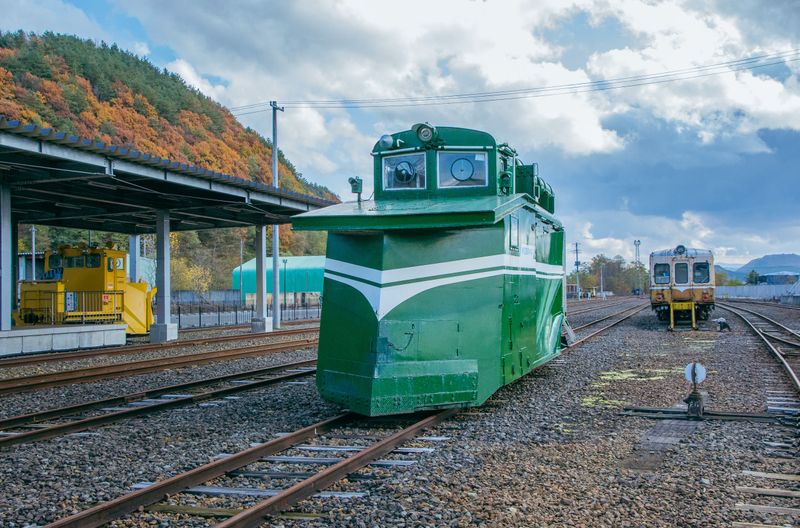
(Kosaka Tetsudo Rail Park)
Depletion of ore reserves in the 1960s was among the factors that brought about the gradual closure of Kosaka’s mines. The town has since employed its mining technology and know-how to help it move into metal recycling industries. In fact, there’s a fair chance that your unwanted smartphone might end up at one of the recycling plants here, according to our guide.
Organizations and administrations in Akita have for a number of years been eyeing a coming together of the industrial heritage, like that of Kosaka, and the environmental and recycling industries of today. Together with the wider region’s rich natural environment, the triumvirate of nature, environment, and industry are pillars upon which the revitalization of the northern Akita region is being built.
Central Kosaka then has the heritage and eco-conscious industry but in terms of tourism, it’s nature that has been carrying much of the weight.
In the years prior to the outbreak of the novel coronavirus of the around 900,000 annual visitors to Kosaka, around 600,000 of these visited Lake Towada and the Towada-Hachimantai National Park, in the northeast of the municipality, according to a Kosaka Town report. By comparison around 50,000 people paid a visit to the Korakukan playhouse making it the second most popular tourist spot in Kosaka.
Lake Towada’s appeals are immediately visible. We approached from the southwest by car stopping off at the Hakka Touge Observatory. The observatory sits on a slope above the southern tip of the lake, the largest crater lake on Japan’s main island of Honshu. (The lake’s circumference is approximate to the circuit made by Yamanote Line trains in central Tokyo, according to our driver.)
From the roof of the observatory you can take in much of Towada’s impressive bulk, looking over the waters to the steep crater wall looming over the lake’s northeastern shores in Aomori Prefecture. It’s a dramatic sight.
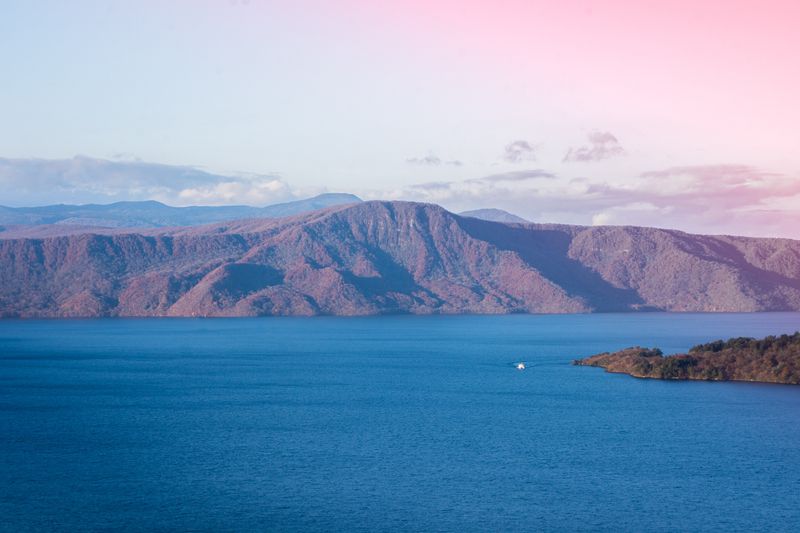
(Lake Towada seen from from the south, approaching from the town of Kosaka, Akita Prefecture.)
Another reason why many visitors are drawn to these parts might be down to the reputation of one of the lake’s accommodation options, the Towada Hotel.
Towada Hotel is a grand dame of Japan's hotel scene. Tell people you’re bedding down for the night here and they’ll send a volley of envious superlatives your way.
Without doubt, the location is stellar, sitting plump on the western crater wall overlooking the lake.
It’s a location to match the ambitions under which the Towada Hotel was built - with eyes firmly fixed on Japan’s hosting of the summer Olympics. Not Tokyo 2020. And, no, not Tokyo 1964. Actually, the Summer Games of 1940, those that we hadn’t heard of until staying at the Towada, perhaps because, ultimately, the games wouldn’t take place.
Bidding for the 1940 Summer Games kicked off in 1932 with Tokyo eventually seeing off competition from Barcelona, Rome, and Helsinki to claim the duties of host. Japan, however, forfeited the right to host the games after invading China in 1937, during the Second Sino-Japanese War. The 1940 Summer Games would ultimately not take place at all, and wouldn’t be held again until 1947 in London.
Despite having been built to welcome the discerning international guest of the 1940s, the Towada, today, is some way off the glitz of a 5-star hotel experience in, say, Tokyo. Rather, to use our driver’s words, “this is your classic Japanese luxury hotel.” Which is to say that it’s a largely retro coming together of Western and Japanese elements, people’d largely by a clientele of retired Japanese who shuffle, “ooh” and “ahh” their way around the hotel’s labyrinth of hallways on their way for soak in the onsen.
From the outside the Towada is said to look something like a Scandinavian mountain lodge. Inside, one of the hotel’s most distinctive features is its old entrance hall, a riot of logs and pillars, many of which come from Akita cedar trees.

(Towada Hotel)

(Entrance hall, Towada Hotel.)
As for the hotel’s lakeside setting, well Lake Towada arguably looks even better from this distance, and a bit of exploration is all it takes to reach its shores.
We rose early in the morning to see if we could find a way down to the lakeshore before breakfast. Success.
A paved pathway sneaks away from the hotel car park, winding underneath the trees to meet with the road which circles the lake. The other side of the road a narrow trail continues on until it hits the lake waters.
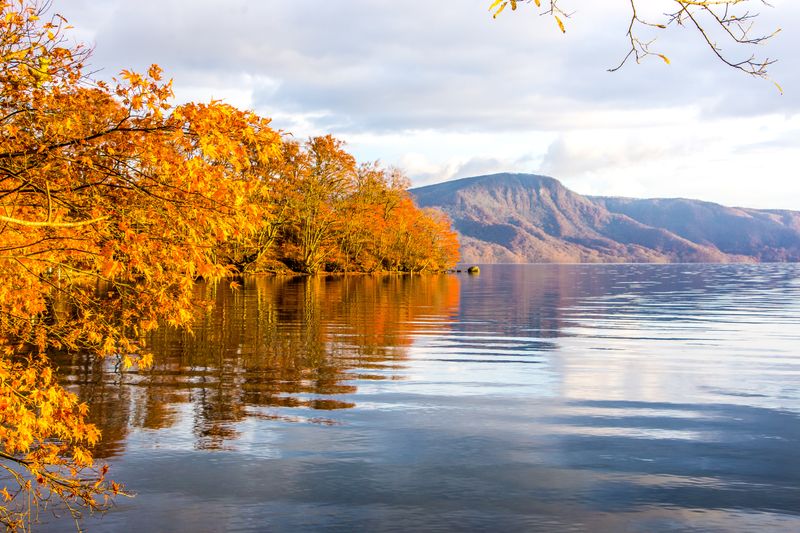
(Early autumn morning, Lake Towada, Akita Prefecture side.)
With the sun beginning to peak above the eastern crater wall the lake waters appeared like rippled glass and the remaining autumn leaves glowed a rich orange. All was quiet save for two people fishing off a small wooden jetty. Perhaps they were hoping to hook one of the famous Himemasu, this area’s signature brand of fish.
Successful in their catch or not, the fishers sure had picked a beautiful spot.
Related
Lake Towada area to spearhead initiative boosting value of Japan's national parks



0 Comments